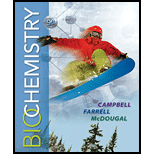
Concept explainers
REFLECT AND APPLY (a) The major energy storage compound of animals is fats (except in muscles). Why would this be advantageous? (b) Why don’t plants use fats/oils as their major energy storage compound?
Interpretation:
The following concept is to be explained
Concept introduction:
The catabolic breakdown of carbohydrates is an aerobic and anaerobic process. There are carbohydrate polymers, such as starch in plants and glycogen in animals, which represent stored energy of the body. These carbohydrates can be hydrolyzed to monomers and then oxidized to provide energy in response to the needs of an organism.
Answer to Problem 1RE
Solution:
Animals use fat as a major store compound for energy. Energy is released when bonds that hold together the molecules in food are broken.
Plants get energy from the sun to break the molecules of water and air during the process of photosynthesis.
Explanation of Solution
Animals use fats/oils as a major energy storage component.
Fats are an important micronutrient for animals. It is a dense source of energy that helps to keep animals active and energetic. It is stored in the body cell and burns itself while doing any strenuous work to provide energy and stamina. Triglycerides is the essential body fat. Since, unlike plants, animals are mobilized, they need high energy for running, flying, catching prey, and other activities. So, the requirement of the energy for such activities is fulfilled by the breaking down of fats in the animal body.
Plants do not use fats/oils as a major energy storage component.
Plants exhibit the process of photosynthesis for the formation of glucose and oxygen from carbon dioxide and water in the presence of sunlight. The excess of glucose in stores in plants, in the form of starch, is the same as glycogen stored in a human body. The breaking of fats in a body is a complex process and not energetically favored. Plants body cannot perform this process as they do not have an enzyme that are required for the breaking or the emulsifying of fats/oils in their body.
Want to see more full solutions like this?
Chapter 21 Solutions
Biochemistry
- write the ionization equilibrium for cysteine and calculate the piarrow_forwardplease answerarrow_forwardf. The genetic code is given below, along with a short strand of template DNA. Write the protein segment that would form from this DNA. 5'-A-T-G-G-C-T-A-G-G-T-A-A-C-C-T-G-C-A-T-T-A-G-3' Table 4.5 The genetic code First Position Second Position (5' end) U C A G Third Position (3' end) Phe Ser Tyr Cys U Phe Ser Tyr Cys Leu Ser Stop Stop Leu Ser Stop Trp UCAG Leu Pro His Arg His Arg C Leu Pro Gln Arg Pro Leu Gin Arg Pro Leu Ser Asn Thr lle Ser Asn Thr lle Arg A Thr Lys UCAG UCAC G lle Arg Thr Lys Met Gly Asp Ala Val Gly Asp Ala Val Gly G Glu Ala UCAC Val Gly Glu Ala Val Note: This table identifies the amino acid encoded by each triplet. For example, the codon 5'-AUG-3' on mRNA specifies methionine, whereas CAU specifies histidine. UAA, UAG, and UGA are termination signals. AUG is part of the initiation signal, in addition to coding for internal methionine residues. Table 4.5 Biochemistry, Seventh Edition 2012 W. H. Freeman and Company B eviation: does it play abbreviation:arrow_forward
- Answer all of the questions please draw structures for major productarrow_forwardfor glycolysis and the citric acid cycle below, show where ATP, NADH and FADH are used or formed. Show on the diagram the points where at least three other metabolic pathways intersect with these two.arrow_forwardanswer the questions please all of them should be answeredarrow_forward
- Burk plot is shown below. Calculate Km and max for this enzyme. show workarrow_forwardInsert Format Tools Extensions Help Normal text ▾ Arial C 2 10 3 + BIUA Student Guide (continued) Record data and conclusions about the mystery food sample either below or in a lab notebook. Step 2: Protein Test (Biuret Solution) Gelatin Water [Mystery Food (Positive Control) (Negative Control) Sample pink purple no change no change They mystery food sample does not contain protein because the color of the test tube wasn't pink or purple Color Conclusion They mystery food sample does not contain protein because the color of the test tube wasn't pink or purple Step 3: Lipid Test (Sudan Red Solution) Vegetable Oil Water (Positive Control) (Negative Control) Mystery Food Sample floating red no change floating red the mystery food dosnt contain lipids because the test tube has floating red 75 % 87 8 9 7 ChromeOS C Device will pow 26.battery lea powerarrow_forwardThe rate data from an enzyme catalyzed reaction with and without an inhibitor present is found in the image. Question: what is the KM and Vm and the nature of inhibitionarrow_forward
- 1. Estimate the concentration of an enzyme within a living cell. Assume that: (a): fresh tissue is 80% water and all of it is intracellular (b): the total soluble protein represents 15% of the weight (c): all the soluble proteins are enzymes (d): the average molecular weight of the proteins is 150,000 (E): about 100 different enzymes are present please help I am lostarrow_forwardPlease helparrow_forwardThe following data were recorded for the enzyme catalyzed conversion of S -> P. Question: Estimate the Vmax and Km. What would be the rate at 2.5 and 5.0 x 10-5 M [S] ?arrow_forward
 BiochemistryBiochemistryISBN:9781305961135Author:Mary K. Campbell, Shawn O. Farrell, Owen M. McDougalPublisher:Cengage Learning
BiochemistryBiochemistryISBN:9781305961135Author:Mary K. Campbell, Shawn O. Farrell, Owen M. McDougalPublisher:Cengage Learning
